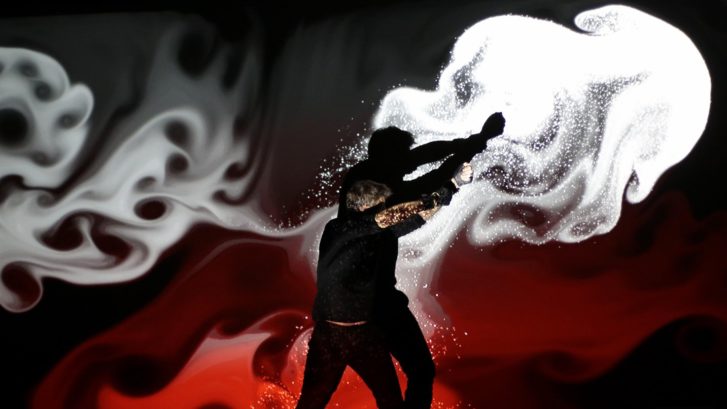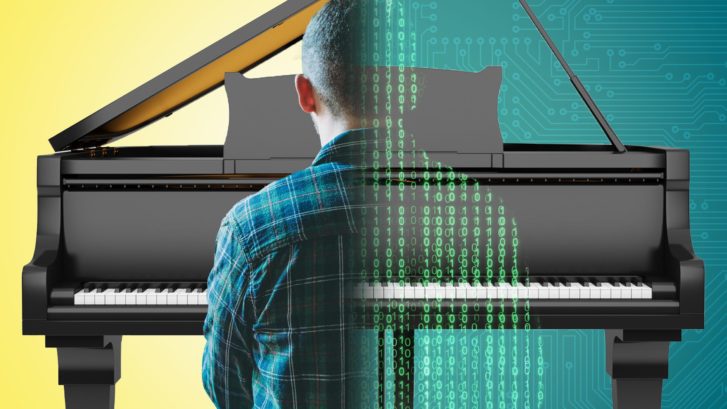Music sculpting art: A performance on the creative process
Saturday 10 December at 8pm – Forum of the Rolex Learning Center, EPFL
Duration: 1h30 – Free admission. All public.
What is improvisation? The experimental project Music Art Sculpt sketches
an answer during its premiere at the Forum of the Rolex Learning Center of
the EPFL
Music, neuroscience and psychoanalysis combine to find
answers. Today, art, culture and new digital technologies interact. Recent neuroscientific
bases show how artistic universes embrace the digital revolution to lead to new forms of
creativity.
The College of Humanities (CH) of the EPFL hosts the premiere of the Music Art Sculpt
project: the assembly of a solo piano, electronic music, sculpted and spatialized percussion,
all generating images projected on a large screen. This experimental project, led by musicians
and scientists, will produce a spontaneous, sonorous and visual creation. On the basis of a
reduced musical framework, without harmony or rhythm, the musicians will give shape to this
material. The notions of improvisation and creativity are at the heart of the project. They will
also be questioned after the concert during a round table discussion with specialists in
neuroscience, psychoanalysis, architecture, art and philosophy. Each of them will discuss
improvisation and creativity in his or her own field and in direct reaction to the experience of
the concert. The question asked: what happened during this moment of sounds and images?
change. This is the fact of improvisation. Can scientists improvise like musicians? In everyday life,
how can improvisation be integrated? “With artists who are used to improvising and with scientists
who improvise in another, perhaps less obvious way, this participatory project will bring some
answers, ” says Véronique Mauron Layaz, head of CDH-Culture. “We are honored to be able to
orchestrate the birth of this project at the École Polytechnique Fédérale de Lausanne (EPFL)!”,
rejoices Richard Rentsch, musician and composer. Also coordinator of artistic projects at the
Agalma Foundation, he manages the project in close collaboration with Philippe Spiesser, principal
professor and head of the Percussion Department at the Haute cole de Musique de Genève.
A laboratory of the unconscious
Prof. Pierre Magistretti, honorary professor at the EPFL, contextualizes: “the Agalma Foundation,
initiator of this dialogue between art, science and technology, tries to understand the unconscious,
especially in its most creative manifestations, such as improvisation. The artists stimulate each other.
They build together. It’s not one or the other, but all of them, together”, explains Prof. François
Ansermet, psychoanalyst.
EPFL intends to show to what extent, in everyday life, the capacity of the human being to compose
with several elements and to put them into shape – in music in this case – is important. “Creating
music, pictorial works, literary inventions, everyone can create his or her life, interpret it. Traces are
inscribed and then, like a score, each person interprets it in his or her own way,” says Prof. François
Ansermet. The idea is to illustrate the creative potential of the human being. Through the encounter
between neuroscience and psychoanalysis, the scientists point out that each human being is first
determined in order not to be determined, in order to be finally free.
A framework without harmony or rhythm
Percussionist Philippe Spiesser’s GeKiPe project explores the themes of gesture in music as an
instrument. “I play invisible percussion and simultaneously trigger sounds and image flows through its
movements,” he explains. The show will start with a light and very simple electronic framework. The
artists come together to build an improvised universe. The digital environment is designed by visual
artist Thomas Köppel. Richard Rentsch, pianist, and Nathan Evans, multi-instrumentalist and
neuroscientist, bring sounds to allow for choreography and Philippe Spiesser reacts to the music and
its rhythm.
Participants in the sound and music creation
• José Miguel Fernandez, composer, computer producer, attended the composition course at
IRCAM
• Thomas Köppel, visual artist
Philippe Spiesser, percussionist, professor and head of the Percussion Department at the
Geneva Conservatory of Music
• Nathan Evans, neurobiologist, musician
The researchers of the round table
• François Ansermet, child psychiatrist, psychoanalyst, honorary professor at the Universities of
Geneva and Lausanne
• Sonia Curnier, architect, researcher in urban theory and sociology, EPFL
• Pierre Magistretti, neurobiologist, honorary professor at EPFL
• Lucienne Peiry, art historian, specialist in Art brut
• Alexander Vert, composer, professor of composition at the CRR of Perpignan
• Claude Welscher, philosopher, anthropologist
Moderation
• Véronique Mauron Layaz, head of the CDH-Culture
Media contact for interviews: Emilie Pralong, 079 816 54
40, emilie@radar-rp.ch


